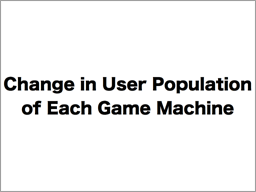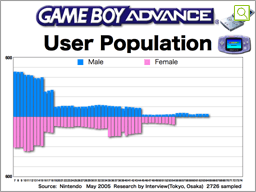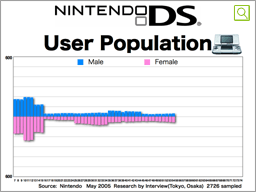Towards the end of this year, licensees are launching many new DS titles, including these on the slides. So, we are anticipating a further decrease in Nintendo's share of total software sales. As for Wii, Nintendo still holds a significantly high share, especially because the hardware was only recently launched, but we are anticipating the same trend as with DS.
As in Japan, expansion of the gaming population because of Wii is currently progressing. In case of DS, the overseas market started to grow a little bit slower than in Japan. But in the case of Wii, markets are expanding around the world simultaneously. A variety of people are interested in Wii and are really enjoying themselves.

Now, I would like you to see how the gaming population has expanded during these two stages. While there are many market research studies demonstrating how many total game machines have been sold, these sales data cannot tell how old the users are nor how many of the purchasers are men and women. Also, since one game machine is most often shared by multiple users, even investigating the purchaser's ages and genders cannot tell you how the actual gaming population has been changing. So, Nintendo has begun interviewing approximately 3000 people twice a year, in Tokyo and in Osaka, in order to explore not just the size of gaming population for each game machine, but also to check the progress of our "Gaming Population Expansion" strategy.
This is the composition of users of Game Boy Advance and Game Boy Advance SP in Japan in May 2005, about 2 and half year ago. Towards the left of the graph, the age is younger, and to the right, it is older. The upper side is male users and on the lower side, females. Nintendo DS was launched in December of the previous year. Nintendogs and Brain Training were launched in April and May of the same year, respectively, but Game Boy Advance was still a significant factor in the market place. As you can see, a great number of younger people were purchasing the product. It was said around this time that the core-users of Nintendo game machines were younger, and it was supported with this kind of data.
At the same time, we researched the same information for DS, and you can see DS users at that time by age and gender. DS's cumulative installed base had not yet reached 3 million, and you can see that the user composition was pretty much the same as that of Game Boy Advance. However, the picture showed significant change as the gaming population started to expand. And now…

